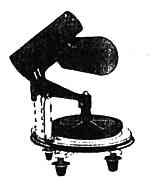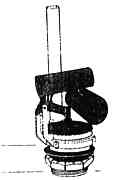
Valve with screw-on disc

Valve snap-on disc
The American Standard tilting flush valve has two fairly large plastic cylinders (black sometimes white) at right angles to each other with a disc attached to the bottom. One type disc unscrews, another pulls off a stub on the bottom. In the illustrations it’s difficult to see the difference; it’s even more difficult when you are looking down into a tank at the top of the valve which makes it very hard to see what you are doing here.
Replacement discs come in the two different styles either snap-on or screw-on, so you should know which one you want before leaving for the hardware store. Fluidmaster has recently made it easier with a single American Standard replacement seat-disc that fits both the snap-on and the screw-on styles.
It’s easy to push back too hard on the top of the valve or pull sideways on the disc and break the valve. So please be CAREFUL with this one. It is best to remove the entire top of the valve so you can see what you are doing. The top part of the assembly on the unit without a hinge bolt is removed by gently slipping a wide-bladed screwdriver between the hinge connections and spread them apart while you lift the top off. The other type has a small bolt that hold the top in place; they are devils to unscrew, but it can be done.
Clean and Polish
After removing the old tank ball, flapper or whatever your tank uses as a plug, clean and polish the edges of a metal seat with fine steel wool. If the seat is plastic, use a non-scratching scourging ball. Examine the surface of the seat for any pit marks or groves before replacing the ball, flapper or whatever. If the surface is not perfectly smooth, the valve will continue to leak after you replace the ball or flapper. In which case, the next step is to cement a new seat and flapper over the old one. (More about this later.)
For now let’s assume the seat looks good. Take the old ball, flapper, disk, etc. with you and go buy a replacement. Securing Refill Tube to Overflow Pipe
Anytime you have worked inside a toilet tank always check and make sure the thin refill tube is directing water into the top of the overflow pipe before you put the tank lid back on. It’s very easy to overlook this little connection. This water running into that overflow pipe is what refills the bowl after a toilet is flushed. A low water level in a bowl is a symptom that the tube has come loose or was not reinstalled the last time someone worked in the tank.
Also check to make sure that when you turn the flush handle that it does NOT hit the underside of the tank lid. If it does the chain to the ball or flapper is too long and must be shortened. When the handle lever is in the resting position with the flapper closed, the chain or strap should have just a tiny bit of slack in it.
Resources
- Learn about American Standard toilets
